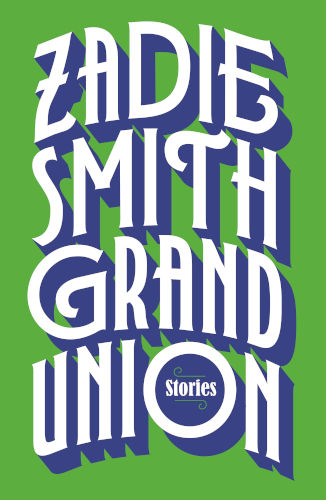Zadie Smith, the accomplished, experimental New Yorker—The JRB Editor Jennifer Malec reviews Grand Union.

Grand Union
Zadie Smith
Hamish Hamilton, 2019
Grand Union, Zadie Smith’s debut collection of short stories, shows a different side of the writer we’ve come to know so well. At times poetic, at times experimental, at times dystopian, her book zigzags through genre and style in a manner that feels unsettlingly haphazard, at first. After a time, however, patterns begin to emerge, and the book carries you along, though the ride may clank and bump like a fairground train.
The collection combines eight previously published short stories, which appeared in The New Yorker, Granta and The Paris Review between 2013 and 2018, with eleven new ones, although the stories are not presented chronologically, nor are they ordered thematically or by setting. Smith is perhaps most popularly known for her fiction writing, but it is widely agreed that it is her two collections of essays, Changing My Mind and Feel Free, that best showcase her brilliance and range. In a way, Grand Union too is a collection of essays, if we take the word at its verbal form of an attempt or effort: the book presents Smith’s literary experiments, her ‘essays’ into historical fiction, science fiction, metafiction and autofiction.
Grand Union, the title of the book, is the name of one of England’s longest canals, which flows from London to Birmingham, branching off to a number of other towns along the way. It’s also, as a common noun, a type of complicated X-shaped junction that allows trams (or trains) arriving from one direction to go off in any of three other directions. These are both apt metaphors for the book’s intersections, and its formal and thematic sojourns. But perhaps most portentously, for those of us keenly following Smith’s career, Grand Union was also the name given to the first flag of the United States of America, hoisted in 1776, which combined the red and white stripes we know today with a miniature version of the British Union Flag in the top left corner. A tempting vexillological symbol: Smith has lived in New York for a decade now, and this is undoubtedly her most American, or perhaps her least British, book.
All of Smith’s five novels have been set in and around north London, close to where she grew up, with occasional forays further afield. The settings in Grand Union are more various: Paris, Boston and London, coastal resorts in Poland and Spain, the seaside town of Felixstowe in the future, a post-apocalyptic island, and a dystopian West African village. The majority of the stories, however, take place in New York, evidence of Smith’s new cultural home, her new comfort zone. The book’s geography is underpinned by New York’s cinematic landmarks—Marcus Garvey and Central parks, Washington Square, Greenwich Village—and occupied by its recognisable types—Abraham Lincoln impersonators, drag queens, ageing punks, migrant shop-owners and beautiful, broke millennial influencers.
When Smith began writing her first novel, White Teeth, she was a precocious twenty-one-year-old Londoner. After it was published, in 2000, the critic James Wood was so incensed by what he saw as its showy plot and its absurd caricatures, its ‘fervid intensity of connectedness’, that he infamously coined a disparaging term for novels in its style: ‘hysterical realism’. The move was curmudgeonly and ungenerous, but it is undeniable that to read Smith’s early novels is to allow character and plot to wash over you in waves. Reading Grand Union, the work of a writer in her middle years, is a less frenetic exercise, a matter of following the twists and turns, of trusting in an author at the height of her powers, perfectly capable of controlling her narrative.
So how should we approach this new Zadie Smith, this accomplished, experimental New Yorker? Perhaps we might take our cue from the author herself. Recalling the James Wood incident in a new interview last month, Smith made the point that, as a reader, you have to accept a writer’s individual sensibility and limitations, you have to ‘meet the book where it lives’.
Grand Union, with its fragments, explorations and variations, lives everywhere. The first two stories present a formidable range of casual references. Words and objects I had to look up in the first few pages include: Sopot, lido, mastaba, Senufo stool, British Knights, cava, the Backs, Nancy Friday, ginkgos—a process that made me wonder at the depth of my ignorance. But then I realised there were a number of references I hadn’t had to look up: Leni Riefenstahl, Kangol, Columbo, panopticon, chimera, MiniDisc player, ululation, Hélène Cixous, four minutes and thirty-three seconds in the context of John Cage. This cultural name-dropping is perhaps an evolution of, or shorthand for, the much-remarked-upon multiculturalism that defined Smith’s early work for many, in a more urbane form. Recognition or non-recognition of such a wide range of objects and ideas is a marker of a type of privilege, and the way in which these allusions are liberally sprinkled throughout the first few stories, before dying down in the second half of the book, does make them seem like an opening gambit: how familiar are you with other things? But more interesting, perhaps, is how what a person recognises maps their history, and their willingness to become actively involved in the text.
This game of ‘30 Allusions’ comes to a head in ‘Escape From New York’, the tenth story in the book, which features three famous people identified only by their first names. It is possible, of course, to read the story without recognising who these characters are, but the experience would be far more bizarre—without the excuse of celebrity they are deeply strange—and far less fun. The hints and clues make for a ridiculously enjoyable experience, like completing a puzzle or being in on an obscure joke.
The more non-linear stories in Grand Union, meanwhile, are satisfying in a different way, although one or two fall flat in places. ‘Mood’, for example, a story made up of a number of vignettes narrated or observed by unnamed characters, opens with a short paragraph on the nature of time that manages to be both devastating and funny, then segues into short but rich character sketches of Roberta, an old punk obsessed with her pug, and Raphael, a stylish and self-obsessed unemployed photographer, before presenting a page and a half of anarchically punctuated Tumblr comments. Despite Kurt Vonnegut’s suggestion that ‘novels that leave out technology misrepresent life as badly as the Victorians misrepresented life by leaving out sex’, writing tech is like walking a tightrope. Ali Smith, in her Seasonal Quartet, is the contemporary author who best manages to capture the terrible poetry of social media. Zadie Smith’s slangy, disjointed rendition, however, doesn’t ring true:
Moods on Tumblr
probably unpopular opinion, but I rly hate those posts that are like “americans who say they are x ethnicity will never be accepted by people from x country! they aren’t really x!”
hello im making this text post since apparently some of you guys have the same amount of manners as a slab of concrete which is none at all
DONT ADD YOUR WEIRDO COMMENTS ON PEOPLES ART. christ.
spicy take
a lot of people on here irrationally hate this show because they conflate its criticism with the way capitalism uses technology with “durr technology is bad fire is scary and thomas edison was a witch.”
I really hate it when goyim use the word Zionist because
okay let’s talk: i’m writing this because 1) i don’t mind being blunt, and 2) i’m more than a little sick and tired of seeing others get taken advantage of or be made anxious.
Smith herself famously does not use social media, does not have a smartphone, and these sinister networks are mentioned just one other time, in a much more subtle and acute way, elsewhere in the book. In ‘The Lazy River’, a group of friends and their small children lounge, out of time, in the circular pool of a Spanish resort by day, while in the evening:
At the elevators, we separate from our friends and their children and ascend to our room, which is the same as their room and everybody’s room, and put the children to bed and sit on the balcony with our laptops and our phones, where we look up his Twitter, as we have every night since January. Here and there, on other balconies, we spot other men and women on other loungers with other devices, engaged in much the same routine.
‘The Lazy River’ is significant, too, as one of the clearest examples of autofiction in the book—a genre that is new to Smith, who has spoken about the ‘moral queasiness’ she feels about using the word ‘I’ in fiction. In her first four novels she studiously avoided first person narration, believing it to be too limiting, too ‘inward facing’, and an invitation for readers—horror of horrors—to conflate the author and her characters. When Smith did eventually write a novel, Swing Time, from the perspective of an ‘I’, she left her unnamed, as if to distance herself from the character; and in her 2018 collection of essays Feel Free, she wrote that for years she thought of the autobiographical in fiction as ‘a kind of weakness, a failure of imagination, something a little embarrassing’. In a conversation with Jeffrey Eugenides in The New York Times after Swing Time was published, Smith mentioned that it was going to therapy for the first time that enabled her to get over this anxiety, adding:
It did seem to me, when I was a kid and also now that I’m a grown-up writer, that a lot of male writers have a certainty that I have never been able to have. I kept on thinking I would grow into it, but I’m never sure I’m doing the right thing.
Another story that appears to be autobiographical, however, ‘For the King’, illustrates with little uncertainty just how Smith’s writing is suited to the form. The story exhibits her effortless style, sparkling dialogue and easy humour, but these successes are boosted significantly by the restrictions of the short story form—fewer characters, a simpler plot—and seem to indicate the possibility of a new direction in her work.
Grand Union contains a number of other writerly departures for Smith too. ‘Meet the President!’ is set in the not-too-distant future, where a boy, locked into some kind of VR gaming device, is forced to detach himself and make a human connection when a small girl needs his help to reach her sister’s funeral. ‘The Canker’, which reads like a fable, is set on an unnamed island, in a post-apocalyptic community led by a man known as the Usurper.
Two of the stories in the collection, ‘Just Right’ and ‘Kelso Deconstructed’, could be called historical fiction, although neither venture too far into the past, both being set in the late nineteen-fifties. This, too, is new ground for Smith (although we are told to expect more from her in the line of historical fiction soon: her forthcoming novel, The Fraud, is said to involve highwaymen in Victorian London). ‘Kelso Deconstructed’ is one of the strongest stories in the collection. It tells the true story of Kelso Cochrane, an Antiguan immigrant to Britain who was killed by a gang of white men in 1959. His death sparked racial tensions, and his murder was remains unsolved. The story humanises a man who has become a myth, and is moving and funny as life is. Smith interposes a Derridean patchwork of texts into the story, including disguised quotations from Paul Gilroy, Toni Cade Bambara and Toni Morrison, what appears to be a real email correspondence with Sally Rooney (credited amusingly as ‘From: YoungIrishWriter@gmail.com, To: OlderEnglishWriter@yahoo.com’), as well as a metanarrative of authorial commentary:
The people are Kelso and Olivia, a couple. The setting a shabby rented room on the Bevington Road, in Portobello. It was Kelso’s room, until five weeks ago, when Olivia moved in. Kelso is from Antigua, originally. He is a carpenter. Olivia is a trainee nurse from Jamaica. They are engaged to be married, although they will never marry: by the time the next sentence arrives it will be Saturday, 16 May 1959, the last day of Kelso’s life.
These different voices nudge you out of the story without detracting from its poignancy, cleverly avoiding a descent into voyeurism.
In her 2009 collection of essays, Changing My Mind, Smith compared being a reader to being a musician, and expanded on the idea in an interview with the Los Angeles radio station KCRW:
The idea we’re given of reading is that the model of a reader is the person watching a film, or watching television. So the greatest principle is, ‘I should sit here and I should be entertained’. And the more classical model is the idea of a reader as an amateur musician, who sits at the piano, has a piece of music, which is the work, made by somebody they don’t know, who they probably couldn’t comprehend entirely, and they have to use their skills to play this piece of music. The greater the skill, the greater the gift that you give the artist and that the artist gives you. That’s the incredibly unfashionable idea of reading. And yet when you practice reading, and you work at a text, it can only give you what you put into it. It’s an old moral, but it’s completely true.
Smith’s early novels, with their pacy plots and effervescent characters, were easy to read and endlessly entertaining. Short stories, by necessity, have starker plots and fewer characters. This, combined with Grand Union‘s variations in form and style, its experimental atmosphere, makes it the perfect book for readers to drop their debut musical-reading mixtapes.





